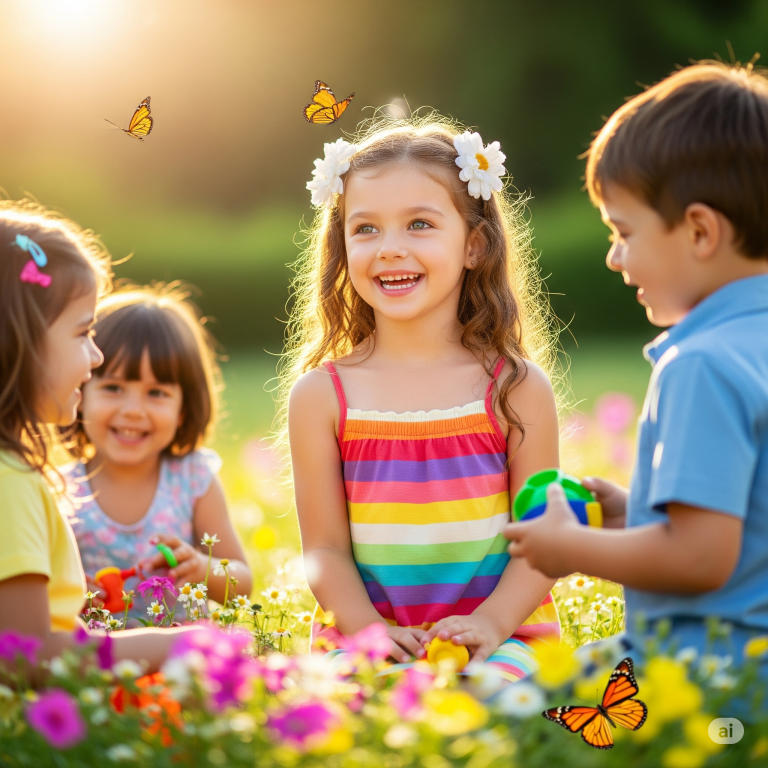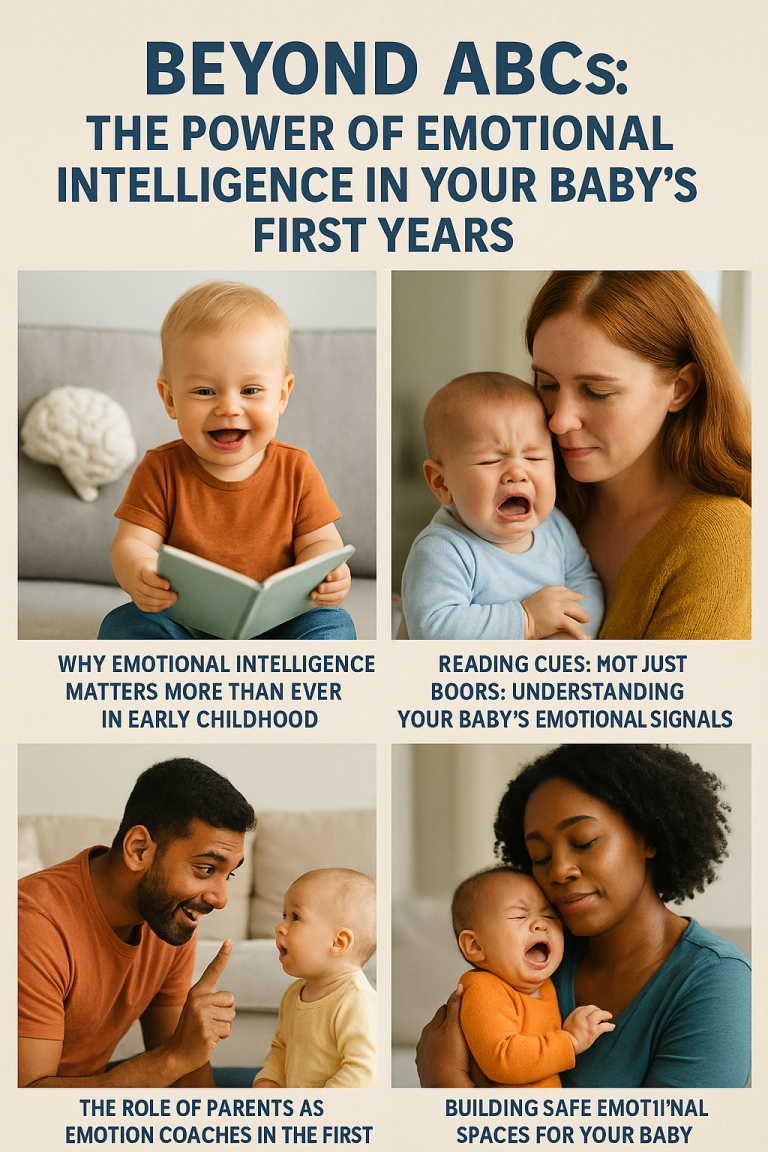
Introduction: The Hidden Curriculum of Babyhood
Before a baby learns to grasp a rattle or say “mama,” their world is awash with feeling. They live in a landscape of sensation, a symphony of touch, tone, temperature, and gaze. Within this subtle ecosystem, the earliest foundations of emotional intelligence are laid—not through formal teaching, but through presence, repetition, and responsive love.
While the world often asks when a child will read, count, or walk, few ask: When will they feel safe? When will they know what it means to be soothed? When will they learn that emotions are messages, not threats?
Emotional intelligence does not wait for preschool to arrive. It begins with the first breath—and grows, silently and powerfully, beneath every coo, cry, cuddle, and gaze. This is the invisible curriculum of babyhood: the quiet, crucial work of helping tiny humans become attuned, resilient, and emotionally fluent.
1. The Emotional Life of Infants: What Science Reveals About Baby Feelings
Contrary to outdated beliefs, infants are not blank slates. They are born with emotional architecture, complete with primitive capacities for joy, fear, interest, and distress. Science now confirms what parents have long suspected: the emotional life of infants: what science reveals about baby feelings is both rich and complex—even before they speak their first word.
Neuroscientific advances reveal that infants’ brains are wired for emotional responsiveness. The amygdala, responsible for processing fear and arousal, is highly active from birth. Likewise, oxytocin—the bonding hormone—spikes during skin-to-skin contact, nursing, and shared eye gazes.
Newborns can distinguish emotional tones in voices and show preferences for familiar caregivers over strangers by just a few days old. They cry in sympathy with other infants, and they respond physiologically to facial expressions—smiling when smiled at, tensing when confronted with anger or fear.
These responses are more than reflexes. They are the first stirrings of empathy, trust, and self-awareness. The emotional experiences babies absorb in these early months form the bedrock of personality and future social functioning.
2. Love as Language: How Touch and Tone Shape Emotional Wiring
Babies do not speak in sentences, but they are fluent in something deeper: feeling.
Love as language: how touch and tone shape emotional wiring reminds us that babies don’t just feel love—they are neurologically sculpted by it. Every caress, lullaby, and gentle whisper serves as a neural cue, firing synapses that support emotional regulation, social learning, and brain development.
The human touch is a biological necessity. Research shows that consistent, affectionate contact improves sleep, digestion, and weight gain in infants. But beyond the physical, touch communicates safety. It teaches the baby’s nervous system to relax, recalibrate, and grow in an environment that feels predictable and secure.
Tone matters just as much. A soft, rhythmic voice signals calm; a jarring, unpredictable tone can activate stress responses. Babies quickly associate sound patterns with emotional states. They begin to read voices the way adults read facial expressions.
This is how emotional fluency begins: not through flashcards, but through rhythm, warmth, and relational trust. The nervous system doesn’t just hear love—it learns from it.
3. Emotions Before Words: The Critical Role of Nonverbal Connection
Long before children form words, they form relationships. These relationships are built on tone, timing, eye contact, posture, and proximity. This is the language of emotion—unspoken, yet deeply understood.
Emotions before words: the critical role of nonverbal connection cannot be overstated. Babies depend entirely on their caregivers to help make sense of internal chaos. They communicate their needs—hunger, fatigue, overstimulation—through cries, gestures, and eye movements. In turn, caregivers interpret, respond, and reflect.
When this dance is in sync, the baby feels seen. Their body calms, their gaze softens, their breath slows. This synchronization between baby and caregiver is called emotional attunement—a shared heartbeat, a shared reality.
Through these moments of nonverbal alignment, babies begin to understand that emotions have rhythm, that discomfort has an end, that connection is available even in distress. These experiences are not fleeting—they’re formative.
The quality of nonverbal connection a baby receives can influence everything from their stress response system to their ability to empathize years later. It’s not what is said, but how it feels, that teaches them how to feel.
4. Mirror Me: How Babies Learn Empathy Through Caregiver Attunement
Empathy isn’t just taught—it’s transferred. Babies begin to understand emotions by witnessing how others respond to theirs.
Mirror me: how babies learn empathy through caregiver attunement refers to the feedback loop that occurs when a caregiver mirrors a baby’s internal state. A surprised face is met with raised eyebrows. A cry is met with a furrowed brow and comforting coos. A giggle sparks one in return.
These moments of reflection tell the baby, “I see you. I feel with you. Your feelings matter.”
This kind of attunement builds the neural foundation for self-other awareness. The child begins to internalize the concept that others have minds, feelings, and reactions. This is the soil in which empathy grows.
Attunement also supports the development of the mirror neuron system—the part of the brain that helps humans imitate, understand, and feel what others feel. A baby who has been mirrored emotionally is more likely to become a child—and later, an adult—who can do the same.
These tiny interactions shape a lifetime of social understanding. The way we meet a baby’s feelings becomes the way they learn to meet the feelings of others.
5. Crying Isn’t the Enemy: Responding to Distress with Presence, Not Panic
A baby’s cry is not a disruption. It is a conversation starter.
Crying isn’t the enemy: responding to distress with presence, not panic urges a shift in mindset. For generations, caregivers were taught to ignore cries lest they “spoil” a child. But modern developmental psychology has rewritten that script.
Crying is not manipulation—it is communication. It’s the baby’s most primal tool to express discomfort, disconnection, or need. When caregivers respond with consistency, calm, and care, the child begins to associate emotional dysregulation with comfort, not abandonment.
More than soothing the surface, the caregiver’s presence begins to reshape the child’s nervous system. Each moment of emotional containment teaches that stress is survivable, that overwhelm can be met with comfort rather than chaos.
Responding doesn’t always mean fixing. Sometimes it means simply being: a hand on the chest, a calm tone, a regulated breath. This non-anxious presence communicates: “You’re not alone. I’m here with you in the hard stuff.”
These moments, though messy, are sacred. They show the child that emotional storms can pass—and that they don’t have to weather them alone.
6. Building the Calm Core: Co-Regulation Strategies That Work from Birth
A calm adult creates a calm child. Not through force, but through resonance.
Building the calm core: co-regulation strategies that work from birth is about helping babies organize their inner chaos through external support. Because infants can’t self-regulate yet, they rely entirely on their caregivers to stabilize their nervous systems.
This process—called co-regulation—happens through warm tone, gentle rhythm, steady breathing, and physical closeness. Holding, rocking, humming, swaying—these aren’t random parental instincts. They are biological tools for nervous system alignment.
Over time, repeated co-regulation experiences become encoded in the baby’s body and brain. They build the capacity for self-regulation—the ability to tolerate stress, delay gratification, and respond rather than react.
Co-regulation doesn’t require perfection. It requires awareness. A caregiver who notices their own tension and recalibrates models emotional flexibility. A parent who apologizes after snapping shows repair is possible.
The baby watches, absorbs, mirrors. The adult’s regulation becomes the baby’s roadmap.
This calm core becomes a lifetime gift—one that cannot be bought, taught, or rushed.
7. From Diapers to Dialogue: Planting the Seeds of Emotional Vocabulary Early
Even before language blooms, the seeds can be planted.
From diapers to dialogue: planting the seeds of emotional vocabulary early emphasizes that babies are listening—long before they speak. When caregivers name emotions out loud, babies begin linking felt experiences with spoken words.
“You’re sad because we had to leave the park.”
“That loud sound surprised you, didn’t it?”
“You’re smiling—you like that song!”
These small verbal cues help the child create an internal map of their emotional world. It becomes easier, later, to say “I’m mad” instead of hitting. Or “I need help” instead of melting down.
Early emotional labeling also increases the likelihood of developing emotional granularity—the ability to distinguish between similar feelings like frustration, disappointment, or boredom. This skill is linked to better emotional regulation and fewer behavioral problems in school-age children.
Books, too, become tools. Stories that name feelings, characters that face challenges, and questions like “How do you think he felt?” build emotional comprehension one page at a time.
Language does more than label—it connects. It builds bridges between experience and understanding, between the inner and outer world.
Conclusion: A Heart-Centered Legacy
Babies are not waiting to become emotional beings. They already are.
The first year is not just a time for physical growth—it is a time of profound emotional construction. Tiny brains are sculpted by love, frustration, comfort, rhythm, rupture, and repair. These earliest experiences lay invisible yet indelible tracks that shape how children feel, relate, and respond for years to come.
The work of raising emotionally intelligent children begins not in preschool, but in the nursery. It is slow, soft, and sacred work. It’s not always Instagrammable, not always neat, not always easy. But it is deeply human.
The lullaby sung during a midnight feed. The hand held through a scream. The naming of a tear. The quiet presence in the chaos. These are not small things. They are everything.
So nurture those tiny hearts. Let them feel it all—the joy, the confusion, the overwhelm, the awe. Give them the space to be seen, heard, and held. Emotional intelligence is not a luxury. It is a necessity. And it begins from day one.




